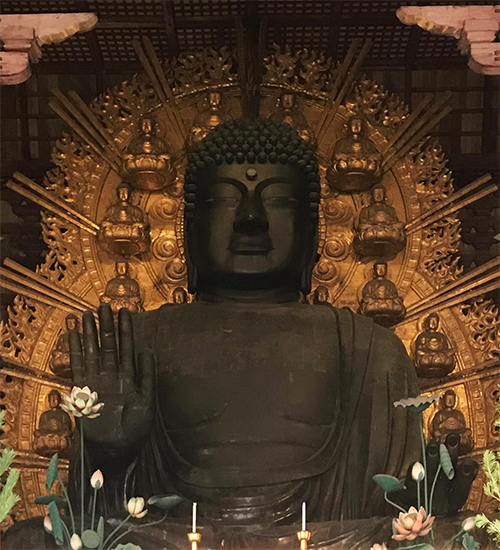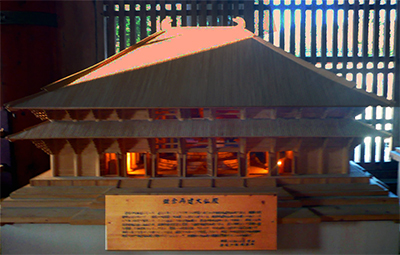

さて大仏さんであります。
この彫像はもちろん人工物であるのに、まるで日本そのもののように
ひとびとに尊崇され続けてきた存在だと言えるでしょう。
制作に携わった技術者・大仏師として国中連公麻呂、
鋳師・高市大国、高市真麻呂らの名が伝わる。余談だが今回自民党総裁選で活躍の
高市早苗さんのルーツなのかも知れない。奈良は彼女の選挙区でもあるし・・・。
大仏建造は天皇聖武が発願し統一国家の象徴としての意味合いも持たせた。
最後の黄金鍍金に際して陸奧国で国産するという僥倖にも恵まれた。
黄金発見の報に接して聖武は年号を改めたりしているし、
開眼会は遠くインドからも国賓を招くなどアジア世界的なイベントにもした。
今日で言えばオリンピックをはるかに越えるレベルで国威発揚させた。
大仏さんが憎くてしょうがないという日本人にわたしは会ったことがない。
王権自身がこの国に仏教を勧請した導入期以降、民も好意的に受容した。
仏教導入期には推進する蘇我氏と反対する勢力の相克があったので
その経緯からすれば在地の八百万神と相克があっても不思議ではないけれど、
日本在地の神々はそのように狭量ではなかったのでしょう(笑)。
しかし1567年11月10-11日にかけての東大寺大仏殿の戦いで焼失したとき、
出火原因は諸説あり当時の宣教師ルイス・フロイスは軍中のキリシタン信徒が
「仏像の破壊」目的で放火したと記録する。有名な記録文書『多聞院日記』では、
「今夜子之初点より大仏の陣へ多聞城から討ち入って数度におよぶ合戦をまじえた。
穀屋の兵火が法花堂へ飛火し大仏殿回廊へ延焼して丑刻には大仏殿が焼失した。
猛火天に満ちさながら落雷があったようで一瞬になくなった。釈迦像も焼けた」
という記述が残されている。狂信的キリシタン信教者にしてみると
許しがたい対象であると思うものなのかも知れない。
仏教思想は発祥地のインドでもやがてヒンズー教などに迫害され
伝播した中国でも繰り返し独裁皇帝権力から弾圧が加えられた。
お隣、朝鮮韓国でも同様に弾圧された歴史が刻み込まれている。
キリスト教による普遍支配が貫徹した欧米社会とは別次元で、
一神教同士の対立、宗教戦争が繰り返された世界史のなかで見れば
平和な信仰心が奇跡的に普遍性をもつ日本人であることが喜ばしい。
内戦があって副次的に派生したこのような例外的事態を除けば、
建立から1,200年間以上尊崇され続けた像というのも奇跡的ではと思う。

上の模型写真は1190年(南都焼討後の再建)-1567年までの大仏殿の模型。
重源さんや運慶による再建によって377年間あり続けた金堂の外観。
戦火受難に際し復元が国家規模で推進され続けたのは国際的に珍しいと思う。
やはり自然な愛着が日本人に芽生えていったのでしょう。
現代まで続いてきた日本人と大仏さんとの永い付き合い、
共に過ごしてきたことそのものが世界遺産なのではないか。
English version⬇
[Japanese nation and Roshana Daibutsu revisit Todaiji Temple-5]
By the way, it is the Great Buddha.
This statue is, of course, an artificial object, but it looks like Japan itself.
It can be said that it has been revered by people.
Kuninaka no Mura, a technician and Buddhist priest who was involved in the production
As a caster, the names of Takaichi Daikoku and Sanae Takaichi are transmitted. As an aside, this time the LDP presidential election
It may be Takaichi’s roots. Nara is also her constituency …
The construction of the Great Buddha was proposed by Emperor Shomu and was given a meaning as a symbol of a unified nation.
I was also blessed with the pretense that it would be domestically produced in Mutsu Province at the time of the final golden plating.
In response to the news of the discovery of gold, Shomu changed his era,
The opening party was also a global event in Asia, such as inviting state guests from India far away.
Today, it has raised national prestige at a level far beyond the Olympics.
I have never met a Japanese who hates the Great Buddha.
Since the introductory period when the royal authority itself solicited Buddhism from the country, the people have accepted it favorably.
During the introduction of Buddhism, there was a conflict between the forces opposed to the Soga clan who promoted it.
From that background, it’s no wonder that there is a conflict with the eight million gods in the area.
The gods in Japan weren’t that small (laughs).
However, when it was burnt down in the battle of the Great Buddha Hall at Todaiji Temple on November 10-11, 1567,
There are various theories about the cause of the fire, and the missionary Luis Frois at that time was a Christian in the Miyoshi army.
It is recorded that it was set on fire for the purpose of “destroying the Buddha statue”. In the famous document “Tamonin Diary”
“From the first point of Koyuki tonight, I struck down from Tamon Castle to the camp of the Great Buddha and mixed several battles.
The fire of the grain shop flew to the Houkado and spread to the Great Buddha Hall corridor, and the Great Buddha Hall was destroyed by fire.
It seemed that there was a lightning strike while being filled with fierce fire, and it disappeared in an instant. The Buddha statue was also burnt. ”
The description is left. For fanatic Christians
It may be something that I think is an unforgivable subject.
Buddhist thought was eventually persecuted by Hinduism in India, the birthplace of Buddhism.
Even in China, where it spread, crackdowns were repeatedly applied by the power of the dictatorship emperor.
The history of repression is also engraved in Korea and Korea next door.
In a different dimension from the Western society where the universal rule by Christianity was pervasive,
If you look at the world history where monotheistic conflicts and religious wars were repeated
I am happy to be a Japanese who has a universal faith in peace.
Except for these exceptional situations, which were secondary to the civil war.
I think it is miraculous that the statue has been revered for more than 1,200 years since its construction.
The model picture above is a model of the Great Buddha Hall from 1190 (reconstruction after the Siege of Nara) to 1567.
The appearance of Kondo, which has been around for 377 years due to reconstruction by Chogen and Unkei.
I think it is rare internationally that restoration continued to be promoted on a national scale in the wake of the civil war.
After all, natural attachment may have sprung up in Japanese people.
In modern times, such a long relationship between Japanese people and the Great Buddha
Isn’t the respect itself for spending time together a World Heritage Site?
Posted on 10月 1st, 2021 by 三木 奎吾
Filed under: 住宅マーケティング, 日本社会・文化研究







コメントを投稿
「※誹謗中傷や、悪意のある書き込み、営利目的などのコメントを防ぐために、投稿された全てのコメントは一時的に保留されますのでご了承ください。」
You must be logged in to post a comment.